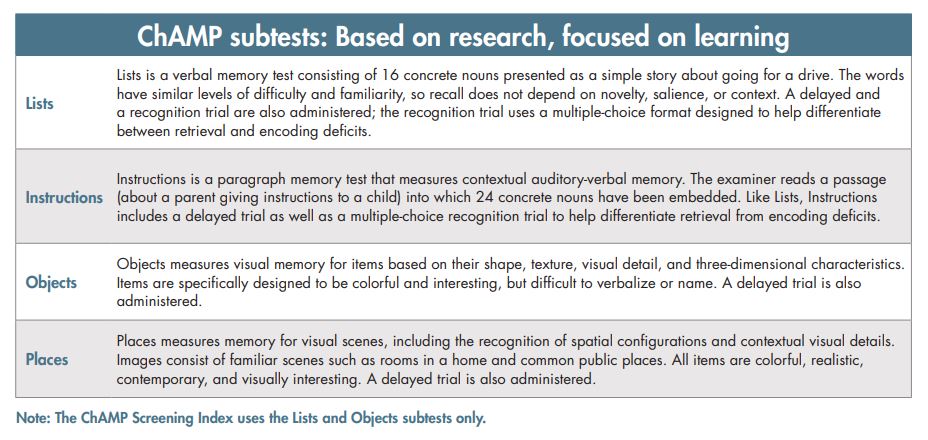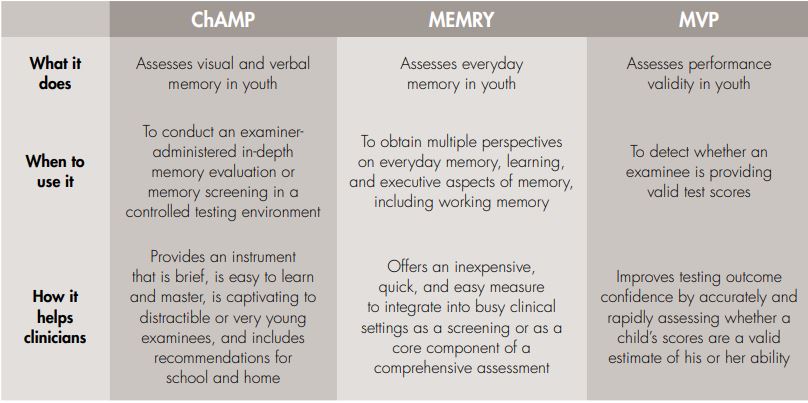Register now and start:
- Accessing PAR Training
- Shopping PAR products & tools
- Using online assessments with PARiConnect
The ChAMP is an easy-to-use, examiner-administered test of memory for use with children, adolescents, and young adults that allows both in-depth memory evaluation and memory screening.

The ChAMP allows for a customizable assessment of storage and retrieval of verbal and visual information, complementing what can be gleaned from tests of working memory (shorter-term retrieval). The ChAMP assesses for memory difficulties seen in many childhood conditions, both neurodevelopmental (learning disabilities, attention problems) and acquired (traumatic brain injury, other neurologic conditions). Each test uses engaging stimuli and multiple-trial learning to minimize demands on attention and working memory, focusing more on memory encoding and retrieval.
Yes! When you need to screen for memory difficulties quickly, the tests for the Screening Index (one verbal, one visual) can be completed in about 10 minutes. When you have specific concerns about memory or if performance on the screening tests raises concerns, the entire ChAMP can be completed in an additional 25 minutes (30-40 minutes total). Subtest scoring is straightforward, and age-adjusted standardized scores can be obtained in minutes on PARiConnect.
Not at all! The ChAMP requires only one stimulus book, which can be displayed in print or digitally, and one record form. The record form uses one page per subtest and includes all the instructions and prompts. There are no response booklets or scraps of paper, and no need to switch between books. The memory delays are built in, so you don’t even need additional tests to fill the time.
The ChAMP Professional Manual has an entire chapter (6) dedicated to interpretation, recommendations, and case examples. The case examples encompass several of the most common disorders associated with varying memory profiles: specific learning disability, ADHD, autism, and traumatic brain injury. Different profiles are mapped onto recommendations, including differential diagnoses to explore, suggested accommodations, and skills to target in intervention.
The ChAMP Professional Manual describes a test-retest sample that was retested 2-3 weeks after initial testing, and a reliable change sample that was retested about 3 months after their initial testing. The test-retest sample was used to calculate the stability of scores over a short time period, a standard metric in demonstrating the reliability of a test. The reliable change sample was retested over a longer interval to mimic real-world clinical practice, where an individual might be retested after a recovery period or intervention in order to measure progress or after a new injury or period of deterioration to measure the degree of new impairment. After you test a child twice, you can generate a Reliable Change Report on PARiConnect that compares the two administrations and highlights significant changes in scores.
When should I use the MEMRY™, ChAMP™, and the MVP?

Each component provides additional information about a child’s memory abilities, and conorming means that all three were standardized on the same large, representative sample. The ChAMP™ is a performance-based memory test with an embedded performance validity indicator and the MVP is a standalone performance validity test. The three forms of the MEMRY allow the student, parent, and teacher to provide their subjective ratings of the child’s real-world memory performance, and it also includes symptom validity scales. Together, these contribute to building a best-practice battery that includes at least two validity metrics. Either the ChAMP™ or MEMRY could be used in screening for memory problems, and the three together form a valuable segment of a comprehensive neuropsychological or psychoeducational evaluation.